Defense Against A Rear Bear Hug Attack -
Part 3
A Low Grab Around The Elbows
By Christopher Caile
Editor's Note: This is the third in
a series of articles on defenses against various kinds of bear hugs.
Part
1 discussed a defense against an attacker moving into the defender
and who grabs him as he is going forward. Part
2 discussed the defense
against a static bear hug attack where a standing attacker grabs around
the defender’s upper arms. Part 3 discusses an attack similar to
that discussed in Part 2, but with the grab lower, around the arms at
the elbow level.
Some readers to this series have questioned bear hug attacks, suggesting
that they are unlikely. That’s not true. When emotions run hot
or when circumstances are high pressure and there is ego, fear or frustrations
boiling over, people often act physically if words fail them. Sometimes
a person will attack with a bear hug just to vent anger or frustration,
not meaning to injure – against a child, small adult or spouse.
Also,
friends, family or others close to you might be kidding around and do
this type of bear hug maneuver. In these situations you might
just want to persuade them to cease, but you don’t want to cause
injury. Here I would suggest a quick and painful pinch. See: “Ouch!
The Mighty Little Pinch For Self-defense.”
Other times a bear hug is used to stop or control a person, or man-handle
the defender someplace, throw them down, or hold them in place (with
the arms pinned) while another person robs or attacks. While in college
I got caught up in a bar fight and was suddenly grabbed from behind in
a bear hug. I used the defense shown in Part 1 and the attacker was fortunately
thrown forward past me. The fight didn’t end there, but that’s
another story. So bear hugs do happen. You should be prepared.
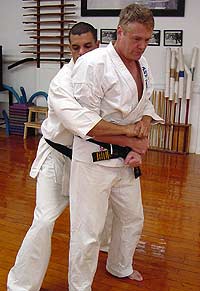 |
A low rear bear hug at the elbow level. |
This article focuses on a type of bear hug where your attacker grabs
you from the rear, low around your upper arms or at your elbow level.
Here, unlike the bear hugs discussed in previous articles, the defense
is more difficult.
The good news, however, is that the attacker has tied up both his arms
and he or she is not hurting you, scaring you possibly, but not injuring
or hitting -- just grabbing and immobilizing you. The attacker could,
of course, try to lift you up to throw you to the ground which could
hurt and lead to further assault, but this subject is left to a future
article. Some of the defenses shown here, however, might interdict any
lifting effort and persuade the attacker just to leave you alone.
One more comment: on stances. A reader of Part 2 of this series on the
rear bear hug e-mailed me and said, “Your stances are terrible.” I
wrote back, “Yes they are, but this is self-defense not karate:
stances in self-defense are usually more natural.” (1) Here we
emphasize what works.
The bear hug discussed in this article is a bit different from those
shown in Part 1 and 2. Here the attacker grabs you low around the upper
arms at elbow level or just above.
In this type of bear hug you will know immediately (by feel, or being
unable to expand your elbows to allow you to slip away as in Part 2)
that your defense will have to be different.
You should initiate a counter-attack. The idea is to turn the table
on the attacker, to overwhelm him or her with a series of quick, powerful
and painful counterattacks – attacks that can injure or incapacitate,
attacks that will turn the attacker into a defender and occupy his mind
and scare him.
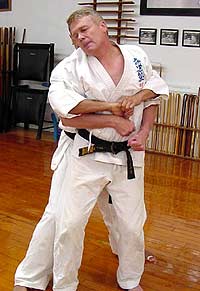 |
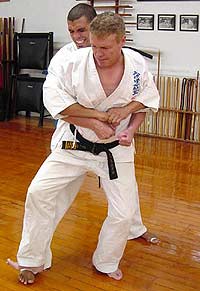 |
Rear head smash |
Foot stomp |
I usually start with a rear head smash (you can usually sense where the
attacker’s
head is) and even if it is out of reach a movement by my head will draw his
attention upward. I follow this with a foot stomp (notice that the foot is
turned to the side) or series of foot stomps (dance on his toes), followed
by a groin strike.
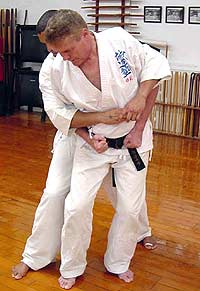 |
 |
Hip movement
|
Groin hit
|
In striking the groin I shift my hips hard and fast to one side. The
opponent is usually quite aware of a potential strike to the groin
and a natural response
is for the attacker to shift his hips to the side too (to protect his groin).
This is just what you want – since if you quickly shift your hips in
the other direction and strike down his groin will be exposed (an alternative
is just to grab the groin or pinch it).
These techniques alone can often suceed in freeing you. Sometimes, however,
more is needed to force the attacker’s arms free.
 |
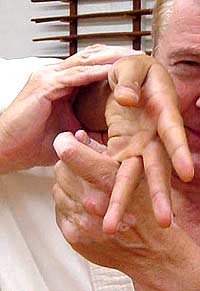 |
Pry the little finger away.
|
Pulling the little finger away,
lift it with the hand, forcing the little finger down. This can
be very painful.
|
One method is to pry away the attacker’s little
finger on his top hand and then lift and pry it backward. The little
finger is always
vulnerable
because it is not strong.
A second and complementary move (which is sometimes not possible
if the grab is so low that it restricts forearm movement) is to
attack the long bones on the back of the opponent’s top hand.
The top of the hand is a sensitive area and these bones (metacarpal
bones that run from the wrist to the first knuckles) (2) can
be easily hurt, injured and broken. In this example I used an extended
knuckle fist, supported with the other hand, and drove it into
the top of the opponent’s hand. At the same time I extend
and tighten my stomach muscles to press outward on the opponent’s
grip as I simultaneously strike with a knuckle fist in the other
direction.
|
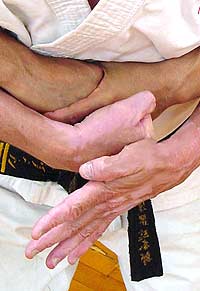 |
Using an extended knuckle
attack, supported with the other hand, attack the back of the
attacker’s hand.
|
|
|
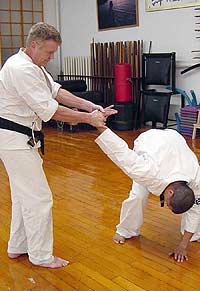 |
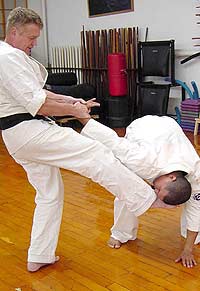 |
If the attacker doesn’t open his arms, pry them
open. This strike can loosen the opponent’s grip so you can
grab a little finger (shown above), or spread the opponent’s
arms which can let you escape. |
If you are versed in aikido or jujutsu, you can also retain control
of one hand and wrist in order to do a wrist lock. You can follow
up with
an arm bar or a kick to the face as shown here.
Footnotes:
(1) Actually the stances in much of traditional Okinawan
karate are relatively higher and more natural than what most students
of Japanese karate today
are used to. Many old masters believed that higher stances provide greater
mobility and enhanced reaction time in movement as compared to stances
of many styles of Japanese karate which emphasize stability (low stances)
and appearance (for kata and in practice).
(2) The back of the hand was
often a target in old Okinawan karate. An old Okinawan adage goes something
like “Take what is presented
to you” (meaning that if someone attacks or kicks at you, attack
the hand or the foot itself rather than other targets that are more distant).
About the Author:
Christopher Caile is the Founder and Editor-In-Chief of FightingArts.com.
He has been a student of the martial arts for over 43 years. He first
started in judo. Then he added karate as a student of Phil Koeppel in
1959. Caile introduced karate to Finland in 1960 and then hitch-hiked
eastward. In Japan (1961) he studied under Mas Oyama and later in the
US became a Kyokushinkai Branch Chief. In 1976 he followed Kaicho Tadashi
Nakamura when he formed Seido karate and is now a 6th degree black belt
in that organization's honbu dojo. Other experience includes aikido,
diato-ryu aikijujutsu, kenjutsu, kobudo, Shinto Muso-ryu jodo, kobudo,
boxing and several Chinese fighting arts including Praying mantis, Pak
Mei (White Eyebrow) and shuai chiao. He is also a student of Zen. A long-term
student of one branch of Traditional Chinese Medicine, Qigong, he is
a personal disciple of the qi gong master and teacher of acupuncture
Dr. Zaiwen Shen (M.D., Ph.D.) and is Vice-President of the DS International
Chi Medicine Association. He holds an M.A. in International Relations
from American University in Washington D.C. and has traveled extensively
through South and Southeast Asia. He frequently returns to Japan and
Okinawa to continue his studies in the martial arts, their history and
tradition. In his professional life he has been a businessman, newspaper
journalist, inventor and entrepreneur.
|